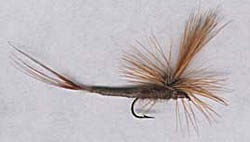| Fly Angler's OnLine "Fly of the Week #30" The Ephemera Vulgataby Lasse Martensson
Delsbo, Sweden
March 23rd, 1998 |

Photo Copyright ©1998 Lesse MartenssonThanks for use permission.
|
 |
Hook: |
Dry fly #12. |
Thread: |
Brown 8/0. |
Body: |
Greyish-brown or olive-brown beaver fur. |
Tail/Abdomen: |
Reversed hackle, dubbed with the body material. |
Wing: |
The stiff guard hairs from a beaver fur patch. |
Hackle: |
Brown or olive-brown; parachute-style. |
With a body length of 18-22 mm (roughly 3/4 to 1 inch), the Ephemera Vulgata
(The Green Drake) is Sweden's second largest mayfly and the hatches can be massive, often
noticed as dark "clouds of smoke" evaporating from the trees along the river. The Vulgata
prefers to hatch in cloudy weather, often after a rainfall around Midsummer, and its attraction
on large trout and grayling has given it a rumour of almost mythical proportions among
Scandinavian flyfishers. The most used imitation is a parachute pattern with burnt hen-hackle
wings, but I prefer this hairwing version because of its durability. The natural also has quite
a massive abdomen and I feel that my dubbed version better resembles the original than
ordinary reversed hackles. Lesse Martensson |
|
Tying Instructions:
- Choose a webby brown or olive-brown hackle feather for the extended body
and press the fibres together, using FlyTite or similar to fix them, leaving the tip for a tail. Leave to dry
for a few moments.
- Dub the feather, excluding the tip. Dip the tip of your finger gently in rubber
glue (photo glue for fixing paper copies works fine) and roll the body between your fingers to make
a slim, rounded abdomen. Leave to dry.
Note: If you want to add ribbing, you can tie a section of tying thread to the feather
before dubbing it. Leave the thread hanging from the tail part and wind it forward in five to six turns,
securing it where the body starts.
- Fasten the hook in your vice and wind the thread to the tying-in point for
the abdomen; over the hook point. Tie in the prepared abdomen and wind the thread to the tying-in
point for the wing
- Cut a bunch of guard hairs from the beaver fur and remove all the scruffy
under fur. Tie in the wing and secure it in the upright position by taking several turns of thread around
the bottom of the post. Reverse the direction of winding to erect the wing.
- Tie in the hackle parachute-style as close to the hair post as possible and
force the hackle feather into an upright position with your thumb nail.
- Take the thread to the rear and dub the rest of the body, leaving just enough
room for a small head at the hook eye.
- Wind the hackle around the hair post, making sure that each turn goes
under the preceding one. About three or four turns is usually enough.
- Tie off the hackle at the head, trim and form a small head. Whip finish.
- Finally, cut off the tip of the reversed feather, leaving just two fibres on each
side to make the tails
"Tying Tip"
For this
Fly of the Week I've chosen one of
my "own" patterns, the Ephemera Vulgata, which is a great working fly.
This fly also involves some tying techniques and
materials that aren't really to be found everywhere else. LM
 |
|